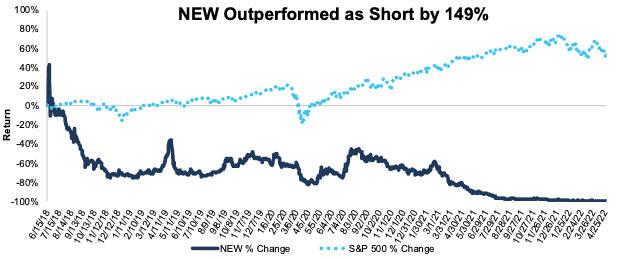Puxin, Ltd (NEW) – Closing Short Position – down 99% vs. S&P up 49%
We put Puxin, Ltd (NEW: $1/share) in the Danger Zone on June 14, 2018 prior to its IPO. NEW earned an Unattractive rating at the time of our report. We believed growing losses and declining margins, along with the added risk associated with investing in a Chinese-based ADR, meant that the expectations baked into the valuation of its stock at time of IPO were overly optimistic.
This report leverages our cutting-edge Robo-Analyst technology to deliver proven-superior[1] fundamental research and support more cost-effective fulfillment of the fiduciary duty of care.
During the nearly four-year holding period, NEW outperformed by 149% as a short position, falling 99% while the S&P 500 gained 49%.
Since our original report, the Chinese government has cracked down on the for-profit tutoring business, and investors have grown wary of investing in Chinese stocks given political tensions and other high-profile cases of fraud. The company still earns an Unattractive rating, earns a -8% return on invested capital (ROIC) over the trailing-twelve months (TTM), and has never generated positive Core Earnings. However, given the stock’s fall to just over $1/share, we’re closing this strongly outperforming short position.
Figure 1: NEW vs. S&P 500 – Price Return – Successful Danger Zone Pick
Sources: New Constructs, LLC and company filings
Note: Gain/Decline performance analysis excludes transaction costs and dividends.
This article originally published on May 4, 2022.
Disclosure: David Trainer, Kyle Guske II, and Matt Shuler receive no compensation to write about any specific stock, style, or theme.
Follow us on Twitter, Facebook, LinkedIn, and StockTwits for real-time alerts on all our research.
[1] Our research utilizes our Core Earnings, a more reliable measure of profits, as proven in Core Earnings: New Data & Evidence, written by professors at Harvard Business School (HBS) & MIT Sloan and published in The Journal of Financial Economics.

